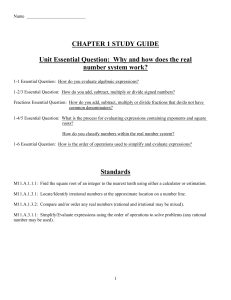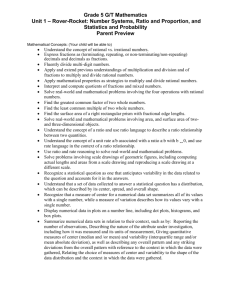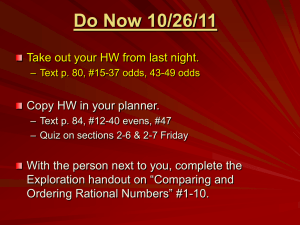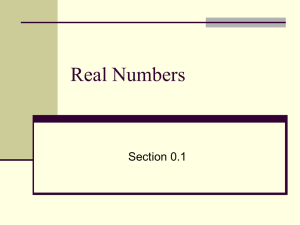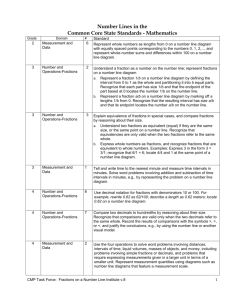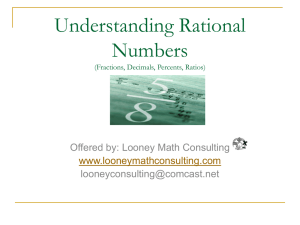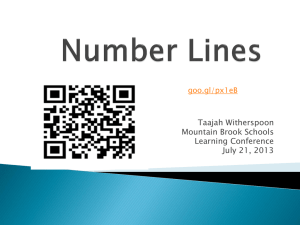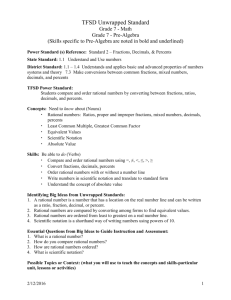PowerPoint Presentation - Common Core State Standards
advertisement
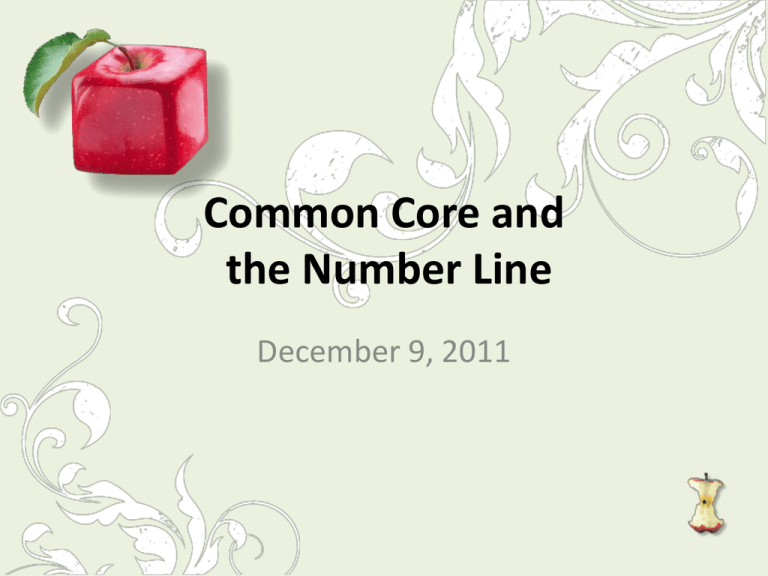
Common Core and the Number Line December 9, 2011 Number Line & CCSS • The number line first appears in the Measurement & Data domain of the Common Core Standards in second grade: – Students are expected to represent numbers as lengths on the number line. – They are also expected to represent sums & differences on a number line. – They utilize counting numbers within 100. http://caccssm.cmpso.org/fractions Grade 2 • Show me: 15 39 56 80 97 Grade 2 15 15 2 13 13 15 + 13 = 28 15 - 13 = 2 = 28 Grade 3 • Number & Operations – Develop understanding of fractions as numbers. 2. Understand a fraction as a number on the number line; represent fractions on a number line diagram. Grade 3 • Spend a few minutes finding the values of the points on the handout. • Discuss your answers with a person or two sitting near you. • Together, organize the problems in the order they should be given to students. 1. 2. 3. | | | | | | | 0 | | 0 http://caccssm.cmpso.org/ | | | ? | | | | | | ? 2 | | 1 | | | | 1 | | | 5 | | | ? | | | 4th grade • Measurement and Data: – Solve problems involving measurement & conversion of measurements from a larger unit to a smaller unit. 2. Use the four operations to solve word problems … including problems that require expressing measurements given in a larger unit in terms of a smaller unit. Represent measurement quantities using diagrams such as number line diagrams that feature a measurement scale. 1 cm = 0.39 inches 1 inch = 2.54 cm One Day 24 Hours is One Day One Hour is 60 minutes 1 Minute is 60 Seconds 5th Grade • Geometry – Graph points on the coordinate plane to solve realworld and mathematical problems. 1. Use a pair of perpendicular number lines, called axes, to define a coordinate system, with the intersection of the lines (the origin) arranged to coincide with the 0 on each line and a given point in the plane located by using an ordered pair of numbers, called its coordinates. Understand that the first number indicates how far to travel from the origin in the direction of one axis, and the second number indicates how far to travel in the direction of the second axis, with the convention that the names of the two axes and the coordinates correspond (e.g., x-axis and x-coordinate, y-axis and y-coordinate). y-axis From the origin (0,0) to point P. I go two units to the right and (x-coordinate, y-coordinate) three units up. P(2, 3) x-axis origin 6th grade • Number Systems – Apply and extend previous understandings of numbers to the system of rational numbers. 7. Understand ordering and absolute value of rational numbers. c. Understand the absolute value of a rational number as its distance from 0 on the number line; interpret absolute value as magnitude for a positive or negative quantity in a real-world situation. For example, for an account balance of –30 dollars, write |–30| = 30 to describe the size of the debt in dollars. | -6 | = 6 because -6 is 6 units from 0. a, if a ≥ 0 |a|= -a, if a < 0 | 4 | = 4 because 4 is 4 units from 0. 1. | 4 | = 4 2. | -6 | = 6 3. - | 8 | = -8 4. - | -2 | = -2 7th & 8th Grade • The Number System – Know that there are numbers that that are not rational, and approximate them by rational numbers. 5. Use rational approximations of irrational numbers to compare the size of irrational numbers, locate them approximately on a number line diagram, and estimate the value of expressions (e.g., π2). For example, by truncating the decimal expansion of 2, show that 2 is between 1 and 2, then between 1.4 and 1.5, and explain how to continue on toget better approximations. 2 5 3 Locate the following irrational numbers on the number line above. 2 2 1.5 3 1.8 1 3 4 1. 3 2.25 3 3.24 1 3 4 2. 1 3 2 2 2 1.7 3 1.8 3. 2 5 1.12 3 1.9 2 2.89 3 3.24 1.21 3 3.61 High School • Statistics and Probability – Interpreting Categorical and Quantitative Data • Summarize, represent, and interpret data on a single count or measurement variable 1. Represent data with plots on the real number line (dot plots, histogram, and box plots. Data Set: The ages of students in the high school Glee Club are as follows: 14, 14, 14, 14, 15, 15, 15, 16, 16, 16, 17, 17, 17, 18, 18 Number of Students Age of Glee Club Members The Number Line • The number line serves as a visual/physical model to represent the counting numbers & constitutes an effective tool to develop estimation techniques, as well as a helping instrument when solving word problems. • The number line constitutes a unifying & coherent representation for the different sets of numbers (N, Z, Q, R) which the other models cannot do. • The number line is an appropriate model to make sense of each set of numbers as an expansion of other & to build the operations in a coherent mathematical way. http://caccssm.cmpso.org/ The Number Line • The number line enables to present the fractions as numbers & to explore the notion of equivalent fractions in a meaningful way. • The number line, in some way, looks like a ruler, fostering the use of the metric system & the decimal numbers. • The number line fosters the discovery of the density property of rational numbers. • The number line provides an opportunity to consider numbers that are not fractions & consider the existence of irrational numbers. http://caccssm.cmpso.org/ Next Steps • Which model for number operations do you now most often use? • Are you ready to begin extending your use of the number line? – Do you have a number line up on the wall in your classroom? • What do you still need to feel comfortable with the number line as a useful representation of number operations?


